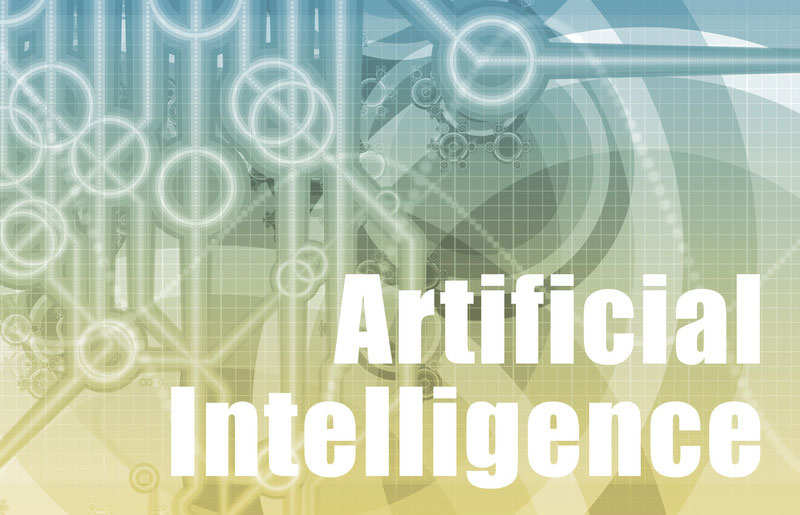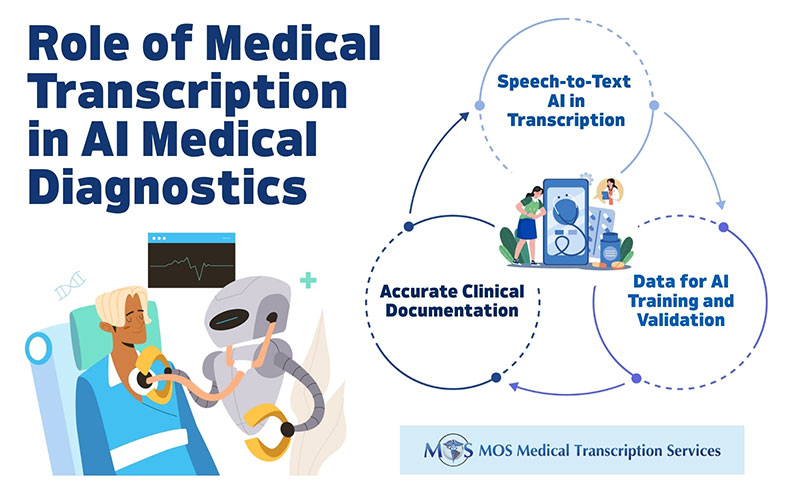
Table of Contents
Most patient-physician encounters lead to a medical diagnosis, which carries significant implications for the patient and guides subsequent treatment. Reaching an accurate diagnosis is a complex process that demands considerable clinical expertise. Artificial intelligence (AI) has transformed the landscape of both clinical diagnostics and medical transcription, enhancing accuracy, speed, and decision-making. Medical transcription services provide the clean, accurate, and detailed textual data that AI systems in medical diagnostics depend on to function effectively and support high quality patient care.
In this post, we explore how artificial intelligence (AI) in medical diagnostics helps in complex clinical data analysis and why accurate transcription is important in diagnostic AI, enabling physicians to make informed diagnoses, develop personalized treatment plans, and more.
Challenges of Medical Diagnosis
Medical diagnosis, the process of identifying a patient’s health condition, is a critical step in healthcare, but it’s often faced with significant hurdles that impact its accuracy and effectiveness. These include the clinical complexity of many diseases with overlapping symptoms, frequent diagnostic errors such as misdiagnosis or delayed diagnosis, and the pressure of limited assessment time in busy healthcare settings.
Other challenges include insufficient diagnostic tools for some conditions, poor communication among healthcare providers, and cognitive biases that affect judgment. The vast and evolving medical knowledge creates information overload, while variability in testing methods adds uncertainty.
Diagnosing rare diseases remains a complex process due to limited experience, and patient-related factors such as delays, healthcare access issues, and disparities. There is also the risk of over-diagnosis leading to unnecessary treatments, aggravated by a lack of formalized training in clinical reasoning.
Together, these challenges complicate the diagnostic process and highlight the need for improved methods and support systems. Addressing them requires ongoing efforts in education, technology, teamwork, communication, and critical thinking. The good news is that AI is making a major difference.
Ensure your practice’s documentation supports smarter diagnostics – explore our medical transcription services today.
Benefits of AI in Medical Imaging and Diagnostics
Diagnostic algorithms can process medical images, including X-rays, MRIs, ultrasounds, CT scans, and DXAs, helping healthcare providers detect and diagnose diseases with greater speed and accuracy. AI can also analyze vast volumes of patient data, such as 2D and 3D medical images, bio-signals, vital signs, demographic details, medical history, and laboratory test results. For example, new AI systems now spot lung nodules and breast cancer with higher accuracy than human radiologists, enabling faster and earlier diagnosis for conditions like cancer and pneumonia.
Chatbots help with symptom checking. Patients type in their symptoms, and the chatbot asks follow-up questions to clarify the situation. For example, apps like Symptomate or Ada Health guide users through a structured Q&A, analyzing symptoms and suggesting possible conditions or next steps, such as seeing a specialist or getting a lab test. Bots can help assess the urgency of a patient’s condition, collect patient information such as medical history and current symptoms before the office visit, and provide personalized health guidance based on user responses. Importantly, unlike human staff they are available at any time to answer patients’ questions.
AI in medical diagnostics offers:
- Enhanced Accuracy: AI helps doctors diagnose diseases by quickly and accurately analyzing medical images and other patient data, making healthcare safer and faster. For example, consider a computer program that looks at X-rays to find signs of lung disease.
Trained with thousands of X-ray images, the AI can identify healthy lungs and diseased lungs. When an X-ray comes in, the AI quickly scans the image and highlights areas that might show disease. An AI analyzing chest X-rays may also consider transcribed physician notes describing “persistent cough for 3 weeks” for a more accurate output. AI has made the process much faster and catches even small details that might be missed by the human eye.
Medical transcription captures detailed nuances (symptoms, history, physician’s reasoning), AI diagnostic systems can combine that text with imaging/lab data to offer more comprehensive diagnostic support.
AI can also predict the likelihood of diseases like lung cancer and pneumonia developing based on patterns in the images and patient data. This means physicians can diagnose these conditions more accurately and earlier than before, leading to better treatment and outcomes for the patient.
Other benefits of AI in diagnostics include:
- Early Detection: Predictive analytics in medical diagnostics can spot early signs of diseases like cancer or heart disease, enabling timely and potentially life-saving interventions.
- Improved Efficiency: Automated systems accelerate the diagnostic process, allowing healthcare providers to dedicate more time to direct patient care.
- Continuous Learning: AI systems can continuously improve by learning from new medical data, research, and clinical outcomes, ensuring diagnostic methods stay current with the latest advancements.
- Cost Savings: By reducing unnecessary tests, minimizing misdiagnoses, and streamlining workflows, AI can help lower overall healthcare costs for both providers and patients.
The latest applications of machine learning in healthcare diagnostics include:
- Genomics and rare disease identification, where AI tools process complex genetic data to diagnose rare genetic disorders quickly.
- AI-powered laboratory diagnostics analyzes tissue samples and blood tests, identifying cancer cells and other abnormalities that might be missed by humans.
- AI models can diagnose diseases such as Parkinson’s by analyzing brain scans and cognitive data, supporting earlier, less invasive intervention and improved patient outcomes.
- Multimodal diagnosis: By combining data from imaging, genetic sequencing, lab results, and patient history, AI platforms provide a more complete, tailored diagnosis.
- Wearable-integrated diagnostics analyze health data from wearable devices for real-time disease detection and remote patient monitoring, enabling earlier interventions without traditional hospital visits.
- Large Language Powered Models (LLM) analyze clinical data and suggest diagnoses, exceeding average physician accuracy in case studies.
These applications are transforming medical diagnostics by improving accuracy, personalizing care, and speeding up results—ultimately making healthcare more effective and accessible
Role of Medical Transcription in AI Medical Diagnostics
Human transcriptionists help AI improve diagnostic accuracy in many ways:
- 1. Speech-to-Text AI in Transcription
AI in medical transcription is rapidly transforming healthcare documentation by using advanced speech recognition and natural language processing to convert live clinical conversations into accurate, structured medical notes in real time. These AI-driven transcriptions can then directly support diagnostic decision-making systems by providing structured, searchable patient information.
- 2. Accurate Clinical Documentation
Medical diagnostics powered by AI relies heavily on structured, high-quality clinical data. Transcription ensures physicians’ spoken notes, observations, and diagnostic impressions are accurately converted into written form. AI algorithms can rely on this accurate documentation to make diagnostic suggestions.
- 3. Data for AI Training and Validation
Transcribed medical records form part of the datasets used to train AI diagnostic tools. For instance, AI models that detect disease patterns in imaging or lab data need accompanying textual clinical documentation (from transcriptions) to validate outcomes.

AI-driven diagnostic tools require precise and complete documentation to avoid misinterpretation. Medical transcription services that emphasize clinical document improvement (CDI) indirectly enhance the accuracy of AI-based diagnostic outcomes. As a medical transcription company, we are also well aware that time is a valuable element when it comes to diagnosis and treatment. The delivery of timely and competent healthcare services can make the difference between life and death, or between healing and disability. Transcription combined with AI-driven diagnostic accuracy in healthcare can promote faster and better therapeutic decision-making, and support billing, reporting, and compliance requirements.


